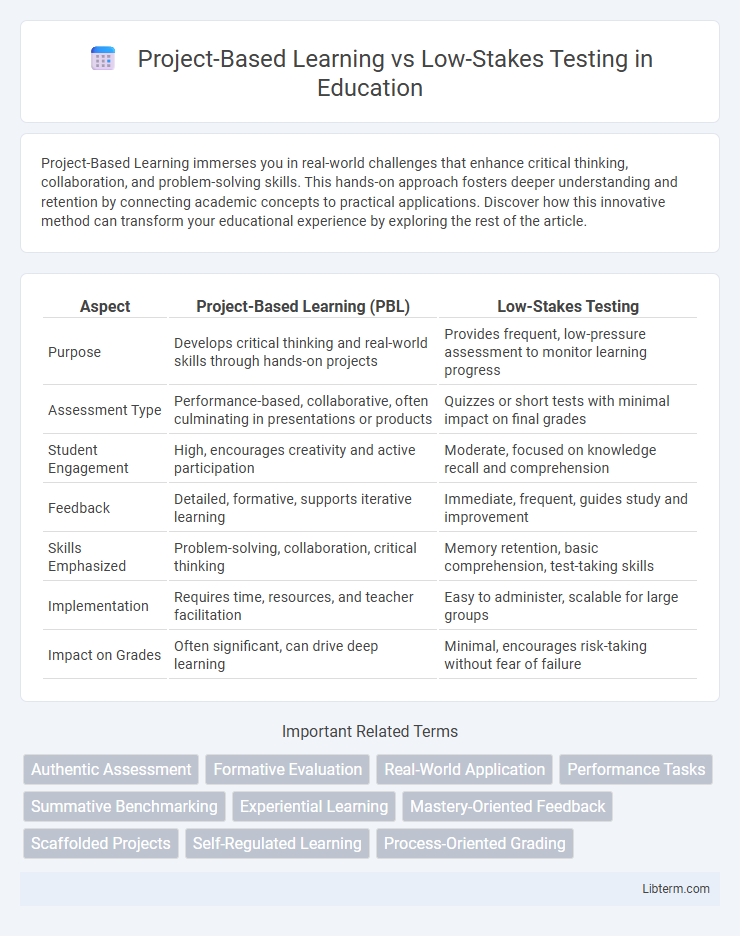Project-Based Learning immerses you in real-world challenges that enhance critical thinking, collaboration, and problem-solving skills. This hands-on approach fosters deeper understanding and retention by connecting academic concepts to practical applications. Discover how this innovative method can transform your educational experience by exploring the rest of the article.
Table of Comparison
| Aspect | Project-Based Learning (PBL) | Low-Stakes Testing |
|---|---|---|
| Purpose | Develops critical thinking and real-world skills through hands-on projects | Provides frequent, low-pressure assessment to monitor learning progress |
| Assessment Type | Performance-based, collaborative, often culminating in presentations or products | Quizzes or short tests with minimal impact on final grades |
| Student Engagement | High, encourages creativity and active participation | Moderate, focused on knowledge recall and comprehension |
| Feedback | Detailed, formative, supports iterative learning | Immediate, frequent, guides study and improvement |
| Skills Emphasized | Problem-solving, collaboration, critical thinking | Memory retention, basic comprehension, test-taking skills |
| Implementation | Requires time, resources, and teacher facilitation | Easy to administer, scalable for large groups |
| Impact on Grades | Often significant, can drive deep learning | Minimal, encourages risk-taking without fear of failure |
Introduction to Project-Based Learning and Low-Stakes Testing
Project-Based Learning (PBL) emphasizes hands-on, real-world problem solving by engaging students in complex projects that develop critical thinking and collaboration skills. Low-Stakes Testing involves frequent, formative assessments designed to reduce anxiety and provide ongoing feedback, promoting knowledge retention and continuous improvement. Together, these methods create dynamic learning environments that balance deep understanding with regular performance evaluation.
Defining Project-Based Learning
Project-Based Learning (PBL) is an instructional methodology where students actively explore real-world challenges and problems through extended projects, fostering critical thinking and collaboration skills. Unlike traditional assessments, PBL emphasizes deep understanding and application of knowledge rather than memorization for testing. This approach contrasts with low-stakes testing, which involves frequent, low-pressure quizzes aimed at knowledge retention and reducing anxiety without significant impact on grades.
Understanding Low-Stakes Testing
Low-stakes testing emphasizes frequent, low-pressure assessments that promote knowledge retention and reduce student anxiety. This approach provides ongoing feedback, allowing educators to identify learning gaps and tailor instruction effectively. Research indicates that low-stakes testing enhances student engagement and supports long-term academic achievement without the stress associated with high-stakes exams.
Core Educational Goals Compared
Project-based learning fosters critical thinking, collaboration, and real-world problem-solving skills by engaging students in meaningful, hands-on experiences, aligning closely with core educational goals of creativity and deeper understanding. Low-stakes testing emphasizes frequent, formative assessments that reduce anxiety and provide ongoing feedback to improve retention and mastery of foundational knowledge. Prioritizing project-based learning nurtures higher-order cognitive skills, while low-stakes testing supports incremental learning and reinforces core content proficiency.
Engagement and Motivation Factors
Project-Based Learning (PBL) significantly enhances student engagement by involving learners in real-world problem solving, fostering intrinsic motivation through meaningful, hands-on experiences. Low-Stakes Testing reduces anxiety and encourages consistent effort, yet may lack the immersive context that drives deep learning and sustained motivation. Combining PBL's practical relevance with the confidence-building aspects of low-stakes assessments creates a balanced environment that maximizes both engagement and long-term academic motivation.
Assessment of Critical Thinking Skills
Project-Based Learning (PBL) enhances critical thinking skills by engaging students in complex, real-world problems that require analysis, synthesis, and evaluation. In contrast, Low-Stakes Testing provides frequent, low-pressure assessments that track incremental development but may emphasize recall over deeper cognitive processes. Research shows PBL's authentic assessments better capture students' ability to apply knowledge creatively and critically in varied contexts.
Impact on Long-Term Knowledge Retention
Project-based learning enhances long-term knowledge retention by engaging students in active problem-solving and real-world applications, fostering deeper understanding. Low-stakes testing promotes retrieval practice, which strengthens memory consolidation and reduces test anxiety, supporting durable learning. Combining these methods can optimize retention by integrating meaningful experiences with consistent knowledge reinforcement.
Inclusivity and Accessibility Considerations
Project-based learning promotes inclusivity by engaging diverse learning styles and allowing personalized, hands-on experiences that accommodate students with varying abilities. Low-stakes testing reduces anxiety and provides multiple opportunities for assessment, supporting accessibility by minimizing barriers for neurodiverse and language-challenged learners. Integrating these approaches enhances equitable education by addressing diverse needs through flexible, student-centered methods.
Real-World Applications and Employability
Project-Based Learning (PBL) enhances real-world applications by engaging students in hands-on projects that simulate workplace challenges, fostering critical thinking and problem-solving skills directly applicable to employment. Low-stakes testing emphasizes frequent assessments with minimal pressure, helping students retain knowledge without anxiety but often lacks direct connection to practical job skills. Employers favor candidates with PBL experience due to demonstrated ability to collaborate, adapt, and apply knowledge in realistic contexts, increasing employability beyond traditional testing metrics.
Choosing the Best Approach for Different Learners
Project-based learning enhances critical thinking and creativity by engaging students in real-world tasks, making it ideal for kinesthetic and collaborative learners. Low-stakes testing reduces anxiety and promotes frequent assessment, benefiting students who thrive with consistent feedback and incremental learning. Selecting the best approach depends on individual learner profiles, cognitive styles, and classroom objectives to optimize educational outcomes.
Project-Based Learning Infographic

 libterm.com
libterm.com